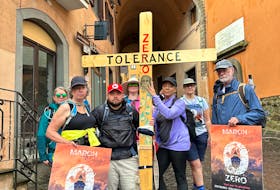That was the big message given by Geoff Parker, senior manager of the Hebron Project, at Friday’s tour of the Bull Arm site and gravity-based structure (GBS).
A lot has been accomplished at the site since The Packet took the tour last year. (Click here to read previous story>>>)
The living quarters have been completed. The seven-story structure was built inside of a fabrication area, with 42-metre-high doors, the second largest in North America after NASA.
“It accommodates 220 people. It has a music room, games room, cafeteria, gymnasium — it’s basically a floating hotel,” Parker told The Packet.
“That complete living quarters will be rolling out of the module hall in July.”
Two drilling modules now sit on the peer. They are undergoing testing and will be attached along with the living quarters later this year.
“On top of that we’ve got the utilities process module, which was completed in Korea. That will be loaded out within the next few weeks. Those four modules will be there in September, and that’s when we start integration and start putting them all together, with the drilling modules and the living quarters going on top of the utilities processing,” Parker said.
The GBS has been at the deep water since being floated out last year. There are 55 metres of the GBS above sea level and 65 metres below sea level.
“Since last year, we’ve completed the roof slab, which goes on top of a central shaft. It’s a 50-metre shaft,” Parker said.
Once they’ve integrated the topside modules in the first quarter of next year, they will be joining the GBS together to form the complete Hebron platform and then the platform will be towed out to the Hebron field.
The Hebron field is expected to produce oil for at least 25 years. Parker said that means there are Newfoundlanders who will work their entire careers on the project.
“There have been countless spin-off jobs as well,” Parker said.
As these final modules are being put in place, the $14-billion project, which began in 2010, will be headed to its finality.
“There’s still a lot of work to go. But when everything comes together here at Bull Arm, that’s when you can really have that line of site to the finish line,” Parker said.
One of Parker’s main points of pride has been the project’s safety record. Historically, North American projects of this magnitude have resulted in multiple injuries and even several deaths, he noted. However, the Bull Arm project hasn’t had any lost time injuries.
“That’s been a credit to everyone who has worked on the project,” Parker said.
That was the big message given by Geoff Parker, senior manager of the Hebron Project, at Friday’s tour of the Bull Arm site and gravity-based structure (GBS).
A lot has been accomplished at the site since The Packet took the tour last year. (Click here to read previous story>>>)
The living quarters have been completed. The seven-story structure was built inside of a fabrication area, with 42-metre-high doors, the second largest in North America after NASA.
“It accommodates 220 people. It has a music room, games room, cafeteria, gymnasium — it’s basically a floating hotel,” Parker told The Packet.
“That complete living quarters will be rolling out of the module hall in July.”
Two drilling modules now sit on the peer. They are undergoing testing and will be attached along with the living quarters later this year.
“On top of that we’ve got the utilities process module, which was completed in Korea. That will be loaded out within the next few weeks. Those four modules will be there in September, and that’s when we start integration and start putting them all together, with the drilling modules and the living quarters going on top of the utilities processing,” Parker said.
The GBS has been at the deep water since being floated out last year. There are 55 metres of the GBS above sea level and 65 metres below sea level.
“Since last year, we’ve completed the roof slab, which goes on top of a central shaft. It’s a 50-metre shaft,” Parker said.
Once they’ve integrated the topside modules in the first quarter of next year, they will be joining the GBS together to form the complete Hebron platform and then the platform will be towed out to the Hebron field.
The Hebron field is expected to produce oil for at least 25 years. Parker said that means there are Newfoundlanders who will work their entire careers on the project.
“There have been countless spin-off jobs as well,” Parker said.
As these final modules are being put in place, the $14-billion project, which began in 2010, will be headed to its finality.
“There’s still a lot of work to go. But when everything comes together here at Bull Arm, that’s when you can really have that line of site to the finish line,” Parker said.
One of Parker’s main points of pride has been the project’s safety record. Historically, North American projects of this magnitude have resulted in multiple injuries and even several deaths, he noted. However, the Bull Arm project hasn’t had any lost time injuries.
“That’s been a credit to everyone who has worked on the project,” Parker said.








